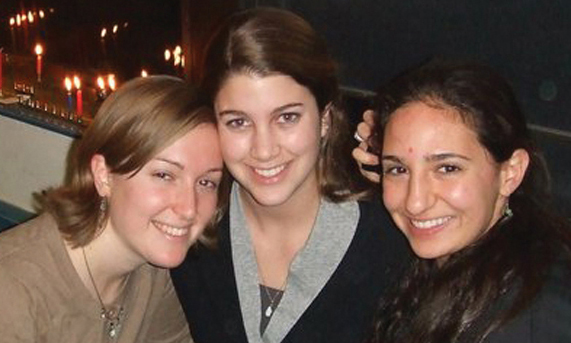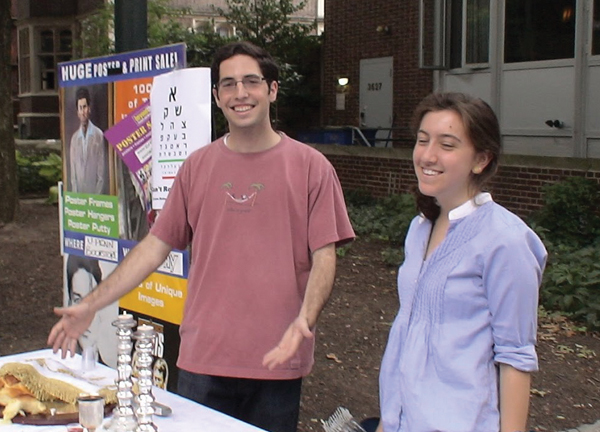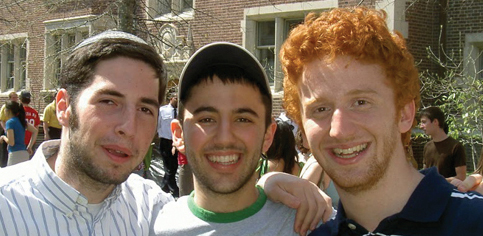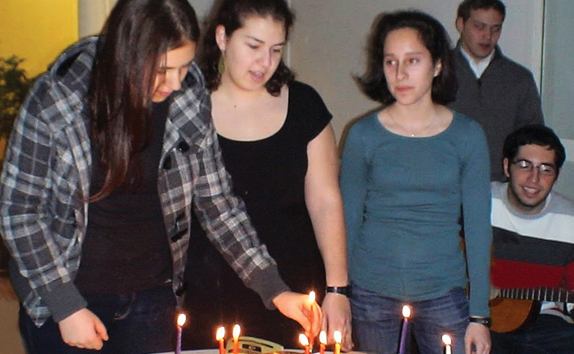REIMAGINING
SHABBAT
ON CAMPUS
by HART LEVINE


T he state of Shabbat life in college can be deceptive. Many campus Hillels and Chabads are bursting on Friday nights with engaged students, innovative programming and dynamic staff. However, no matter how amazing the offerings are, these institutions are considered successful if they reach just 10 or 20 percent of Jews on campus through weekly Shabbat dinners. Some blame the core communities at Hillel and Chabad for being intimidating, exclusive or of no interest to the majority of Jews on campus. Others think traditional events like Shabbat dinners are an archaic and ineffective engagement model, or that Judaism itself needs revamping.
As a student at the University of Pennsylvania and as someone whose life revolved around weekly Shabbat dinners and the community that formed around them, I felt that a solution to this problem might lie within. I was part of such a beautiful and meaningful community — albeit one whose walls were hard to climb — and I wished we could find ways to open it up to those on the outside.
So we set out to try. Finding students who were strangers to Jewish life and outsiders of the Jewish community seemed to be a challenge, until we realized that we all knew people who were Jewish but not actively involved — from classes, dorms and activities around campus. My friends and I started inviting these students to Shabbat dinners, but instead of bringing them to Hillel or Chabad, we created our own welcoming Shabbat spaces in our homes, our apartments and our dorms. Some of these guests were new to Shabbat (a few had just found out they were Jewish), some had minimal exposure (through grandparents, summer camp or an occasional showing at Hillel or Chabad), and some had grown up religious (perhaps even studying in Israel before college) but neglected it when they got to campus. For whatever reason, these students weren’t coming to Hillel or Chabad — but Shabbat at a friend’s apartment? Sure, they said, why not?
Of course, there’s more to being Jewish than having a bunch of Jews together, and our Shabbat dinners filled that role by providing a framework of meaningful Jewish content. During the meal, we would introduce and share the rituals and their themes — Shalom Aleichem and welcoming, Kiddush and sanctity, Hamotzi and sustenance, Birkat Hamazon and gratitude. There would sometimes be a song and often an ice-breaker, but other than that there was no script — it was just students sharing of themselves with their peers in an authentic and genuine manner. And because the hosts were actively engaged Jewishly, the Shabbat meals were transformed into spaces and micro-communities of meaningful Jewish life.


IN SOME ways, the greatest outcomes from the Shabbat meals were the friendships formed around the tables between people from across the involved/uninvolved divide.
Since these meals were run by regulars of the Jewish community, they also served as entryways to further Jewish and communal involvement. Hearing the blessings and liturgy of Shabbat dinner led to requests for Hebrew lessons and the beginnings of peer-based Hebrew learning programs; falling in love with the songs and zemirot led to appearances at tishes and at Jewish a cappella concerts; and asking inquisitive and probing questions led to follow-up conversations and weekly chevrutas.
In some ways, the greatest outcomes from the Shabbat meals were the friendships formed around the tables between people from across the involved/uninvolved divide. These relationships were also the means through which outsiders could venture in and become integrated into a meaningful and sustainable community at Hillel or Chabad.
These student-led dinners also served to challenge a certain assumption about Jewish life. I remember telling a friend about the dinners and she asked, “So which rabbi runs them?” After I explained that it was actually just run by students, she responded, “No, I know, but which rabbi makes the blessings and does the rituals?” Her inability to understand our model of student-led dinners seems to be symptomatic of a larger trend in today’s Jewry — that most people don’t see themselves as authentically Jewish or capable. It’s easy to see why this is so, given that the most pervasive spiritual models involve rabbis. Our Shabbat dinners were the perfect opportunity to demonstrate peer-led and home-based Judaism. Here were people who lived and breathed Shabbat but who were also regular students, friends and classmates. This made it relatable and tangible, showing that rabbis aren’t the only members of the community who do Shabbat or live Jewishly. Our dinner companions saw that they, too, could be owners, shapers and hosts of their Judaism.
What started out as a few dinners run by my friends and me has turned into an organization called Heart to Heart, named for the personal relationships and meaningful connections on which this model is based. Working in close partnership with the OU, we have organized 450 dinners over the past three years on 40 campuses for 6,255 students — 60 percent of whom were previously uninvolved in Jewish life. Now I know I didn’t invent this — Jews have been keeping Shabbat for thousands of years, and we’ve been welcoming strangers into our homes since Abraham and his tent. But what we have created is a network, a movement, of thousands of college students and young adults who live and breathe Jewish life, sharing and creating experiences, relationships and community with their peers — which is exemplified best through the mindful mixing of regulars and non-regulars around a Shabbat table.
There’s something powerful about the intimacy and serenity of Shabbat that is sometimes lost in cafeteria-style dining halls and their crowded, endless tables. But seat 15 Jewish college students around a table, give them a framework and some food, and something magical will happen: strangers, acquaintances and friends will turn into a community. ■
Hart Levine is the Director of Heart to Heart, a grassroots movement of Jewish students and young adults sharing Jewish life with their peers.
| PREVIOUS ARTICLE | NEXT ARTICLE |